Challenging "Masamune" by kokaji
Recently I heard the story of missing sword "Honjo Masamune".
That brought me an idea to make a copy of the sword, since I live in a
village next to "Honjo" city. It is a kind of joke. What is more,
I got some request from customers to copy Masamune tanto blade. So I will
challenge to make Masamune style a little bit. I hope it is interesting
for customers.
- At first, what is Soshu style? -
Shape : There is no typical style in Soshu tradition, but it depends with the period.
Steel : It is famous that the steel of Soshu blades is mix forging. That
means hard steel and soft steel are mixed.
When the Kamakura government became weak around the beginning of 14th century,
they no longer had power to invite master smiths from the west Japan. That
is the background of developing Soshu style. And probably, lack of good
steel as material also would be caused. The furnace in the western Japan
had a system to be specialized to make hard steel mainly. On the other
hand, that in the eastern Japan was not so, and it made various kinds of
iron those are soft steel, hard steel, and cast iron. In the east Japan
there are many cast iron Buddha statues instead of bronze ones in the west
Japan. The fact may illustrate that cast iron is more popular in the east
Japan than in west Japan. In that situation, smiths in Kamakura city tried
to create good steel by the method of mix forging. Mild steel can become
harder by adding some amount of too hard steel. Cast iron is too hard (brittle)
to forge by hammer, but it can be used by smith through Oroshi-gane method.
Mix forging is common way to save good steel (proper hardness for edge).
But still, the steel of Soshu blades doesn't look so sensitive comparing
with good Bizen blades in the same period. Then, those steel have to be
heated and quenched from higher temperature to get proper hardness on edge.
Such work makes the steel crystallization larger.
Steel construction : I have studied many Soshu blades, so-called "Soshu style" blades, and fake ones. I studied several Masamune in museums, but I have never studied real Masamune in my hand. All of my Masamune in my hand were no signature. And so were Sadamune. Studying real Soshu blades, all of them have the wrapping style in steel construction. It is kobuse, makuri or some style like that. On the other hand, many of "Soshu style" blades or fake blades have three layers style (sam'mai, hon-sam'mai, or like that). It is strange. It is Mino style
in fact.
Hamon and utsuri : As I mentioned, the hamon is made of large particles
what is caused by high temperature heating at the hardening work. The hamon
pattern is straight or choji. And sometimes other patterns also are found.
But it is difficult to distinguish natural activity and intentional design.
Anyway the hamon pattern is not well ordered because of high temperature
heating. It looks attractive for peoples eye. The utsuri is not very clear,
but still exist. Sometimes it is clear as shirake pattern. Unfortunately,
it is difficult to research utsuri in the blades with modern polishing.
Such a polishing work emphasizes the layer pattern to show it more Soshu
style like.
Honjo Masamune
- About Honjo Masamune - (Information from some books)
Blade length 65.2cm
Curvature 1.7cm
Shape : shinogi-zukuri style, two surface back, wide blade with thin thickness,
long kissaki, narrow shinogi-ji, high shinogi line.
Steel texture : small wood grain layer pattern is dense, fine steel particles,
chikei (by mix forging?).
Hamon : made of small particles (ko-nie), its pattern is O-midare and ko-midare
with jumping hamon, kinsuji, ashi.
No engravings
Tang : O-suriage (no original tang remains), end is kengyo shape, 1 peg
hole.
There is one big nick on the edge at the lower part of blade, and several
smaller nicks on the edge and on the back.
- Forging -
Select the steel
I selected the steel pieces that come from the lowest priced tamahagane from NBTHK. Those include uneven hardness in themselves. It may be close to the situation of Soshu smiths in the end of Kamakura period.
Outer steel (in Kobuse style), I picked various hardness of steel pieces.
They are totally hard enough for edge and folded 15 times.
Core steel, the steel pieces those are a little softer than the outer steel
are selected, and folded 14 times.
And then, the outer steel and the core steel are constructed with Kobuse style.
I supposed the original shape of "Honjo Masamune".

Blade length is 77cm, thickness at the base 8mm, width 3.3cm
Steel is fine and clear, but the steel texture looks a little larger than
my usual work. I am not sure if it is because of the mix forging or higher
temperature heating in hardening work.
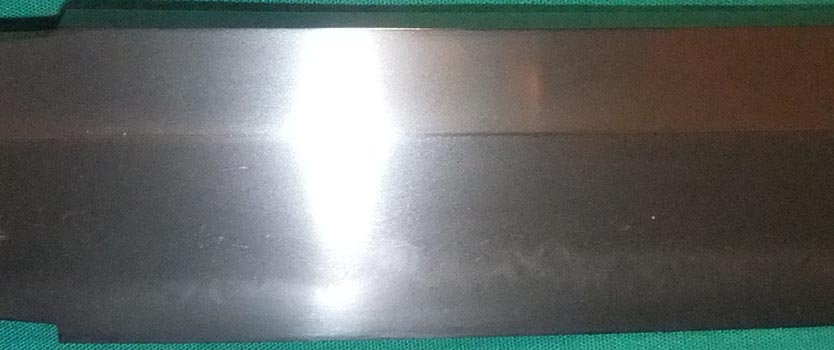
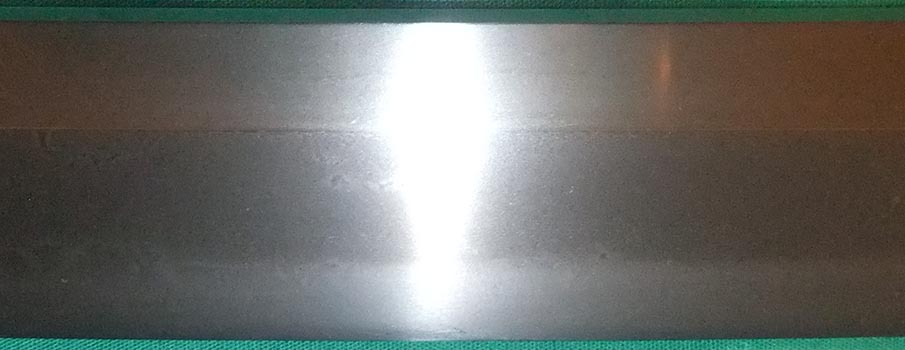
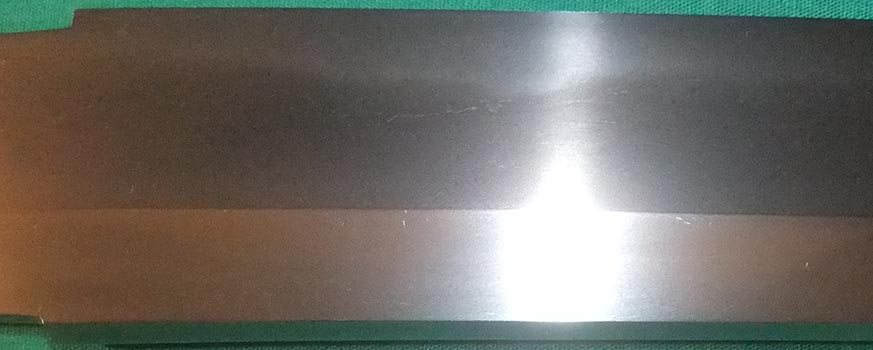
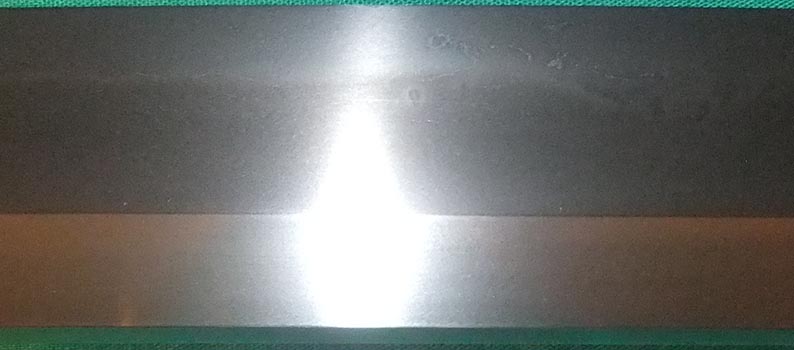
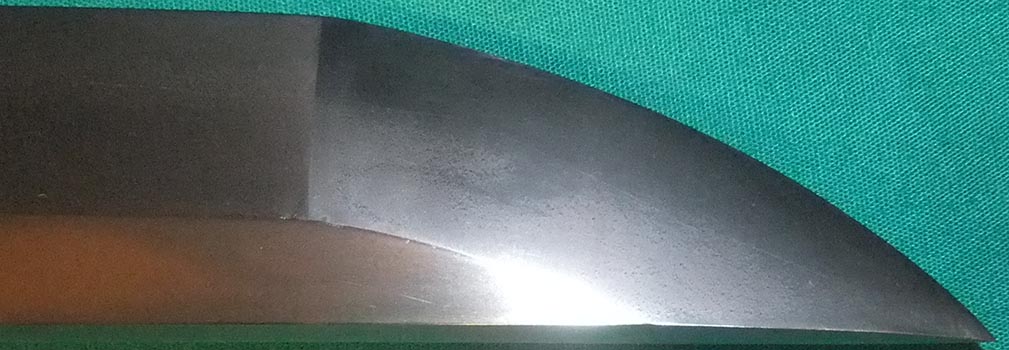
Hamon is made of large particles, and those become larger toward the upper
part. The hamon pattern is choji, komidare and some tobiyaki (jumping hamon),
so it is a kind of hitatsura.
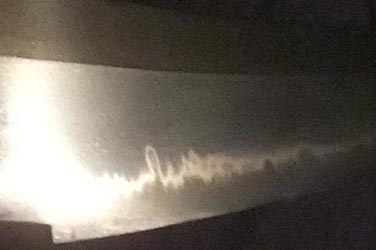
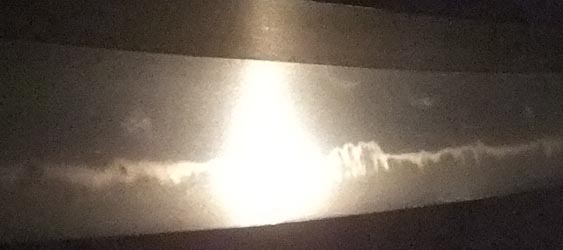
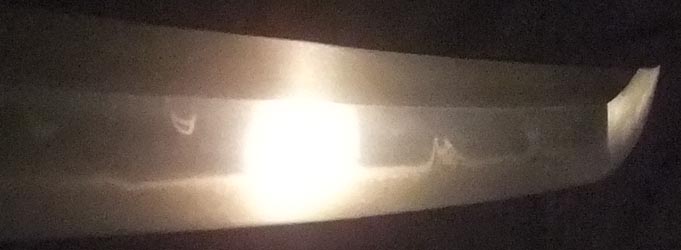

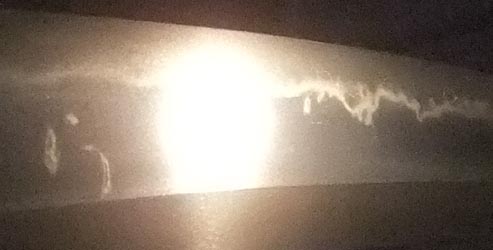
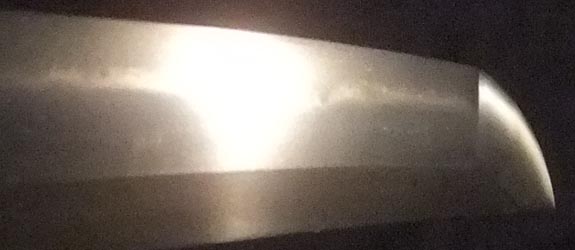

Of course, tachi "Masamune" are no signature, and neither is this. So the signature "Kodaira" is on the back.

Habaki is old, probably from the early 17th century. It is damaged, but
good for joke.
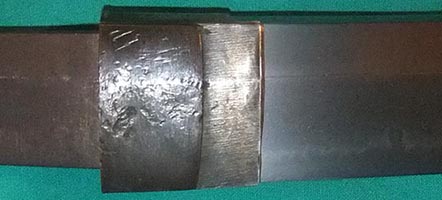
Conclusion
Comparing with some of Masamune blades and most of the blades attributed
to Masamune, this steel is finer and the temper line (hamon particle band)
is tighter than them. Most of the blades attributed Masamune have large
layer pattern and wide temper line, and the steel layer and hamon are influenced
each other. I am not sure if it is genuine Masamune, but such swords are
so-called "Masamune style". To get such an appearance, I should
select more different quality steels (harder steel pieces and softer steel
pieces) among mix forging, and fold less times. The total hardness also
should be softer than this to harden it with higher temperature. Then the
blade can look more like "Masamune" what has many attractive
patterns for eye. But still I have a question, if such a blade is good
as weapon. Of course I know that, soft and tough edge is better than sharp
and brittle edge in some situation.
Home > Gallery, Interesting swords > Challenging Masamune